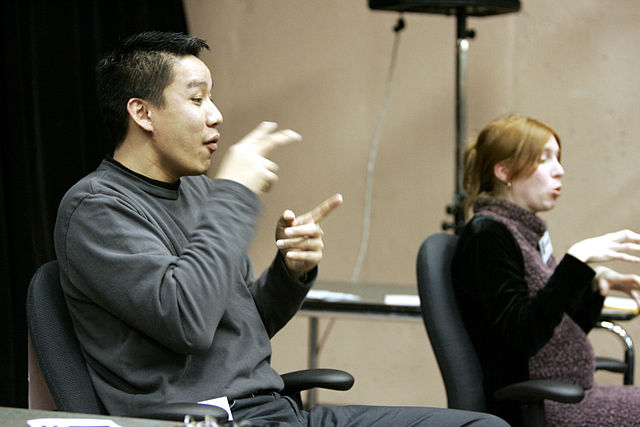About This Course
This course is an introduction to consecutive sign language interpreting theory and practice between Deaf and nondeaf people. Upon successful completion of this course, students will demonstrate they can:
- incorporate practical applications of non-judgmental language (Colonomos, Witter-Merrithew, et al.) in evaluating personal and colleague work product (professionally talk about our work)
- describe and evaluate the academic and theoretical contributions of significant educators and practitioners in the interpreting field (Cokely, Colonomos, Patrie, Witter-Merrithew, Taylor, Dean & Pollard, et al.) (understand historical context for sign language interpreting theory)
- identify and incorporate a best-practice taxonomy of competencies and processes required to produce consecutive interpretations (identify what skills are required)
- demonstrate and self-monitor basic abilities required to create consecutive interpretations of rehearsed and/or spontaneous texts:
- understand how principles of the Demand-Control Schema (DC-S) can undergird ethical and best-practice interpreting decisions
- increase competent usage of source language (sL) and target language (tL) (Cokely)
- recognize a typology of interpretation miscues (Cokely, Gonzalez) and monitor their manifestation in interpretations
- describe and apply the cognitive tasks of pegging, chunking, linking, and monitoring to understand a discourse
- organize and map (Witter-Merrithew, Monkowski & Winston) both distinctive and discrete units of information for an interpretation
- reformulate both abstract and concrete message parts (Patrie, Colonomos) of a discourse into a consecutive interpretation
- identify impacts on and incorporation of semantic choice, register, and ethical behavioral decisions in consecutive interpretations
A significant portion of this course requires self-directed efforts (asychronously working with other teammates) and fairly good command of web-based technologies and learning environments (video creation, salient discussion and reporting skills; we’ll discuss this more in class).
This course requires a one-hour per week lab criteria; students should expect to spend at least an hour a week on skill-building exercises in a language laboratory setting.

http://upload.wikimedia.org/wikipedia/commons/thumb/b/bf/Interp.jpg/640px-Interp.jpg
What others have said about this course:
“...The class has a good vibe and makes it easy to talk and state your opinion.”
“...I really enjoyed being in this class and I think that what I learned here will forever influence what I do in the interpreting field. The way he breaks down the information is awesome. It really changes the way you approach interpreting.”
“...This class was extremely helpful in teaching interpreting techniques.”
“...He cares about us as people as well as wants us to succeed and that is awesome because it creates a much safer environment where we feel free to make mistakes because we know he will help us learn from them and not make us feel small.”
“...He had clear examples that helped us understand what we were discussing...I learned different ways that I had not thought of before.”
“...He was very helpful in teaching us things that would really help us out in the interpreting field. I loved all the hands up time we got in class. He did very good at making the class feel like a non judging zone.”
Published Course Description and Prerequisites
In keeping with a January 2016 request from the University’s Department of Languages and Cultures, the original course description and prerequisites are listed below. The current learning objectives at left/above on this site/page are expansions and clarifications of the original expectations: